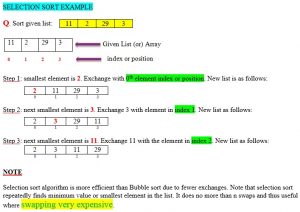


Some more examples of the reason for wanting stable sorts. You can't stack unstable sorts in the same fashion. However, where last names are the same, the first names are sorted. After these sorts, the list is primarily sorted by the last name. We could first sort (stable or unstable) by the first name, then stable sort by the last name. We are asked to sort "by last name, then by first". Now to answer your question, suppose we have a list of first and last names. (by the way, that algorithm is called radix sort) We could sort the list of words using this algorithm: stable sorting by column 5, then 4, then 3, then 2, then 1.

In an unstable sort algorithm, straw or spork may be interchanged, but in a stable one, they stay in the same relative positions (that is, since straw appears before spork in the input, it also appears before spork in the output). If we sort the list by just the first letter of each word then a stable-sort would produce: apple Suppose we have a list of 5-letter words: peach And some sorting algorithms are not, like Heap Sort, Quick Sort, etc.īackground: a "stable" sorting algorithm keeps the items with the same sorting key in order. Some sorting algorithms are stable by nature like Insertion sort, Merge Sort, Bubble Sort, etc. The index for the pivot now is 1, by this time, no more recursive calls on the smaller arrays of this subarray will be made because we have reached the base case, the condition (lo = hi is met.A sorting algorithm is said to be stable if two objects with equal keys appear in the same order in sorted output as they appear in the input array to be sorted. Now the left subarray has 3 elements and 3 is picked as a pivot, after partitioning, this subarray will then become and considered sorted. Then, we can further call the quicksort function on the left and right of the pivot. Here is how our array being changed after the first call to the partition function:Īfter the first call to the partition function is settled, the pivot is now placed correctly and the position of the pivot is obtained. In the third step we recursively apply these two steps to these sub-arrays, now we have the left sub-array, then we pick 3 as the pivot, then reorder the subarray, now it will become, then on the right subarray 6 is picked the pivot, the right subarray then become. Then the second step is we move all elements that are less than 5 to the left and all the greater to the right, after partitioning, our array might look like:, elements are placed in the correct positions with respect to the pivot, however, as we can easily notice, the order of elements on the left and right intervals are not correct. The first step is we need to pick a pivot element, for the sake of simplicity, we pick the last element as the pivot, so our pivot here is 5. Let’s make things more clear, for example, we have the array. There are various different implementations for the Quicksort algorithm, here we examine the pseudocode from one of them, which is used to sort elements from low to high of an array A: /* Lomuto partition scheme for quicksort algorithm */ Then recursively apply these 2 steps in smaller sub-arrays until all of them are sorted.Rearrange elements so which all elements which are less than the pivot will be moved to the left array, all elements greater than the pivot will be moved to the right array. Partitioning by dividing the array into two smaller arrays.First, pick an element, called pivot from the array.Quicksort applies the divide and conquer paradigm as follow: At the end of this article, I hope you can understand what is the quicksort algorithm, how it could be implemented, its time and space complexity. This sorting algorithm was invented by Tony Hoare in 1959 (which was a really long time ago but still widely used today!). In this article, I want to introduce to you one of the most efficient sorting algorithms of all time, far better compared with these algorithms above, named Quicksort. These sorting algorithms have some similarities, the first thing is they’re being taught in the college all the time in some introductory courses, the second thing is they are quite easy to implement, however, the most prominent correlation between them is they all labeled as not-so-efficient sorting algorithms with the average and worse case of. Perhaps you’re already familiar with some sorting algorithms such as Bubble Sort, Selection Sort, or Insertion Sort. There are a multifarious number of sorting algorithms have been proposed and being used nowadays.


 0 kommentar(er)
0 kommentar(er)
